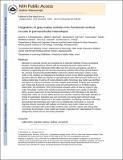Integration of gray matter nodules into functional cortical circuits in periventricular heterotopia
Author(s)
Barnard, Mollie E.; Katzir, Tami; Chang, Bernard S.; Christodoulou, Joanna; Del Tufo, Stephanie Nicole; Whitfield-Gabrieli, Susan; Gabrieli, John D. E.; ... Show more Show less
Downloadnihms530181.pdf (694.6Kb)
PUBLISHER_CC
Publisher with Creative Commons License
Creative Commons Attribution
Terms of use
Metadata
Show full item recordAbstract
Alterations in neuronal circuitry are recognized as an important substrate of many neurological disorders, including epilepsy. Patients with the developmental brain malformation of periventricular nodular heterotopia (PNH) often have both seizures and dyslexia, and there is evidence to suggest that aberrant neuronal connectivity underlies both of these clinical features. We used task-based functional MRI (fMRI) to determine whether heterotopic nodules of gray matter in this condition are integrated into functional cortical circuits. Blood oxygenation level-dependent (BOLD) fMRI was acquired in eight participants with PNH during the performance of reading-related tasks. Evidence of neural activation within heterotopic gray matter was identified, and regions of cortical coactivation were then mapped systematically. Findings were correlated with resting-state functional connectivity results and with performance on the fMRI reading-related tasks. Six participants (75%) demonstrated activation within at least one region of gray matter heterotopia. Cortical areas directly overlying the heterotopia were usually coactivated (60%), as were areas known to have functional connectivity to the heterotopia in the task-free resting state (73%). Six of seven (86%) primary task contrasts resulted in heterotopia activation in at least one participant. Activation was most commonly seen during rapid naming of visual stimuli, a characteristic impairment in this patient population. Our findings represent a systematic demonstration that heterotopic gray matter can be metabolically coactivated in a neuronal migration disorder associated with epilepsy and dyslexia. Gray matter nodules were most commonly coactivated with the anatomically overlying cortex and other regions with resting-state connectivity to heterotopia. These results have broader implications for understanding the network pathogenesis of both seizures and reading disabilities.
Date issued
2013-10Department
Massachusetts Institute of Technology. Department of Brain and Cognitive Sciences; McGovern Institute for Brain Research at MITJournal
Epilepsy & Behavior
Publisher
Elsevier
Citation
Christodoulou, Joanna A. et al. “Integration of Gray Matter Nodules into Functional Cortical Circuits in Periventricular Heterotopia.” Epilepsy & Behavior 29, 2 (November 2013): 400–406 © 2013 Elsevier Inc
Version: Author's final manuscript
ISSN
1525-5050
1525-5069